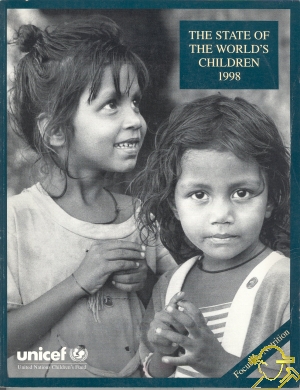The State Of The World's Children 1998
İÇİNDEKİLERcontentsforeword by Kofi A. Annan, Secretary-General of the United Nations Chapter I Malnutrition: Causes, consequences and solutions vlalnutrition is rarely regarded as an emergency; the children affected are not facing famine and betray few or 10 obvious signs. Yet the largely invisible crisis of malnutrition is implicated in more than half of all child ieaths worldwide and violates children's rights in profound ways, compromising their physical and mental ievelopment and helping perpetuate poverty. More widespread than many suspect — with one out of every hree children affected —■ malnutrition lowers the productivity and abilities of entire societies. This chapter examines the scale of this intractable tragedy, the approaches that are helping resolve it and the new light that scientific research is shedding on it. The silent emergency: In this section, the scale of malnutrition and the complex interplay of factors that ;ause it, including poor health services and discrimination against women, are presented. Approaches that work: Community involvement, food fortification, growth monitoring and promotion, supplementation programmes — these are some of the many and often overlapping approaches that are ;hanging, and saving, children's lives. Bringing science to bear: Vitamin A reduced maternal death rates by 44 per cent on average, according to i recent study. This section spotlights some of the breakthroughs that science is making in the fight for better uitrition. Chapter II Statistical tables Statistics, vital indicators of the care, nurture and resources that children receive in their communities and countries, help chart progress towards the goals set at the 1990 World Summit for Children. The eight tables in this report have been expanded to give the broadest possible coverage of important basic indicators for nutrition, health, education, demographics, economic indicators and the situation of women, plus rates of progress and regional summaries. They also include complete data, as available, on less populous countries, covering 193 countries in all, listed alphabetically. Countries are shown on page 93 in descending order of their estimated 1996 under-five mortality rates, which is also the first basic indicator in table 1. Panels 1 Vitamin A supplements save pregnant women's lives 2 What is malnutrition? 3 Stunting linked to impaired intellectual development 4 Recognizing the right to nutrition 5 Growth and sanitation: What can we learn from chickens? 6 Breastmilk and transmission of HIV 7 High-energy biscuits for mothers boost infant survival by 50 per cent 8 UN1CEF and the World Food Programme 9 Triple A takes hold in Oman 10 Celebrating gains in children's health in Brazil 11 Rewriting Elias's story in Mbeya 12 Women in Niger take the lead against malnutrition 13 BFHI: Breastfeeding breakthroughs 14 Tackling malnutrition jn Bangladesh 15 rlwants mobilize to end iodine deficiency*s deadly toll 16 Indonesia makes strides against vitamin A deficiency 17 Making food enrichment programmes sustainable 18 Zinc and vitamin A: Taking the sting out of malaria 19 Protecting nutrition in crises 20 Progress against worms for pennies 21 Child nutrition a priority for the new South Africa Spotlights World Food Summit Ten steps to successful breastfeeding Vitamin A Zinc Iron Iodine FOLATE Text figures Fig. 1 Malnutrition and child mortality Fig, 2 Trends in child malnutrition, by region Fig. 3 From good nutrition to greater producttvity and beyond Fie. 4 Poverty and malnutrition in Latin America and the Caribbean Fig. 5 Causes of child malnutrition Fig. 6 Inadequate dietary intake/disease cycle Fig. 7 Intergenerational cycle of growth failure Fig. 8 Better nutrition through triple A Fie. 9 Iodine deficiency disorders and salt iodization Fig. 10 Progress in vitamin A supplementation programmes Fig. 11 Measles deaths and vitamin A supplementation Zinc supplementation and child growth (Ecuador, 1986) Fig. 13 Maternal height and Caesarean delivery (Guatemala, 1984-1986) References Index Glossary    |



